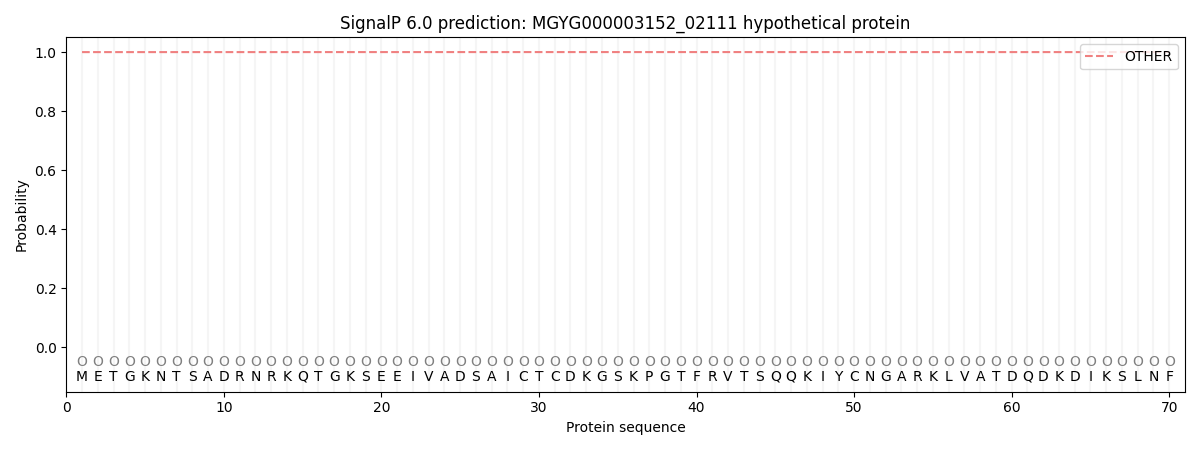You are browsing environment: HUMAN GUT
CAZyme Information: MGYG000003152_02111
You are here: Home > Sequence: MGYG000003152_02111
Basic Information |
Genomic context |
Full Sequence |
Enzyme annotations |
CAZy signature domains |
CDD domains |
CAZyme hits |
PDB hits |
Swiss-Prot hits |
SignalP and Lipop annotations |
TMHMM annotations
Basic Information help
| Species | Prevotella denticola | |||||||||||
|---|---|---|---|---|---|---|---|---|---|---|---|---|
| Lineage | Bacteria; Bacteroidota; Bacteroidia; Bacteroidales; Bacteroidaceae; Prevotella; Prevotella denticola | |||||||||||
| CAZyme ID | MGYG000003152_02111 | |||||||||||
| CAZy Family | GH19 | |||||||||||
| CAZyme Description | hypothetical protein | |||||||||||
| CAZyme Property |
|
|||||||||||
| Genome Property |
|
|||||||||||
| Gene Location | Start: 68713; End: 71856 Strand: - | |||||||||||
CAZyme Signature Domains help
| Family | Start | End | Evalue | family coverage |
|---|---|---|---|---|
| GH19 | 582 | 775 | 4.1e-18 | 0.5454545454545454 |
CDD Domains download full data without filtering help
| Cdd ID | Domain | E-Value | qStart | qEnd | sStart | sEnd | Domain Description |
|---|---|---|---|---|---|---|---|
| COG3179 | COG3179 | 4.38e-19 | 565 | 721 | 7 | 131 | Predicted chitinase [General function prediction only]. |
| pfam14107 | DUF4280 | 1.19e-15 | 23 | 125 | 1 | 109 | Domain of unknown function (DUF4280). This family of proteins is functionally uncharacterized. This family of proteins is found in bacteria and eukaryotes. Proteins in this family are typically between 129 and 456 amino acids in length. There is a single completely conserved residue C that may be functionally important. |
| cd12797 | M23_peptidase | 1.31e-08 | 878 | 1002 | 1 | 85 | M23 family metallopeptidase, also known as beta-lytic metallopeptidase, and similar proteins. This model describes the metallopeptidase M23 family, which includes beta-lytic metallopeptidase and lysostaphin. Members of this family are zinc endopeptidases that lyse bacterial cell wall peptidoglycans; they cleave either the N-acylmuramoyl-Ala bond between the cell wall peptidoglycan and the cross-linking peptide (e.g. beta-lytic endopeptidase) or a bond within the cross-linking peptide (e.g. stapholysin, and lysostaphin). Beta-lytic metallopeptidase, formerly known as beta-lytic protease, has a preference for cleavage of Gly-X bonds and favors hydrophobic or apolar residues on either side. It inhibits growth of sensitive organisms and may potentially serve as an antimicrobial agent. Lysostaphin, produced by Staphylococcus genus, cleaves pentaglycine cross-bridges of cell wall peptidoglycan, acting as autolysins to maintain cell wall metabolism or as toxins and weapons against competing strains. Staphylolysin (also known as LasA) is implicated in a range of processes related to Pseudomonas virulence, including stimulating shedding of the ectodomain of cell surface heparan sulphate proteoglycan syndecan-1, and elastin degradation in connective tissue. Its active site is less constricted and contains a five-coordinate zinc ion with trigonal bipyramidal geometry and two metal-bound water molecules, possibly contributing to its activity against a wider range of substrates than those used by related lytic enzymes, consistent with its multiple roles in Pseudomonas virulence. The family includes members that do not appear to have the conserved zinc-binding site and might be lipoproteins lacking proteolytic activity. |
| COG0739 | NlpD | 7.38e-07 | 838 | 1013 | 135 | 259 | Murein DD-endopeptidase MepM and murein hydrolase activator NlpD, contain LysM domain [Cell wall/membrane/envelope biogenesis]. |
| pfam01551 | Peptidase_M23 | 1.22e-06 | 876 | 1002 | 1 | 87 | Peptidase family M23. Members of this family are zinc metallopeptidases with a range of specificities. The peptidase family M23 is included in this family, these are Gly-Gly endopeptidases. Peptidase family M23 are also endopeptidases. This family also includes some bacterial lipoproteins for which no proteolytic activity has been demonstrated. This family also includes leukocyte cell-derived chemotaxin 2 (LECT2) proteins. LECT2 is a liver-specific protein which is thought to be linked to hepatocyte growth although the exact function of this protein is unknown. |
CAZyme Hits help
| Hit ID | E-Value | Query Start | Query End | Hit Start | Hit End |
|---|---|---|---|---|---|
| QUB90499.1 | 0.0 | 1 | 1047 | 1 | 1047 |
| QUB76016.1 | 0.0 | 1 | 1047 | 1 | 1046 |
| QUB70001.1 | 0.0 | 1 | 1045 | 1 | 1034 |
| AUI55267.1 | 0.0 | 1 | 1045 | 1 | 1029 |
| QUB81456.1 | 0.0 | 1 | 1047 | 1 | 1035 |
PDB Hits download full data without filtering help
| Hit ID | E-Value | Query Start | Query End | Hit Start | Hit End | Description |
|---|---|---|---|---|---|---|
| 4OK7_A | 8.95e-07 | 601 | 721 | 54 | 151 | ChainA, Endolysin [Salmonella phage SPN1S],4OK7_B Chain B, Endolysin [Salmonella phage SPN1S],4OK7_C Chain C, Endolysin [Salmonella phage SPN1S] |
Swiss-Prot Hits download full data without filtering help
| Hit ID | E-Value | Query Start | Query End | Hit Start | Hit End | Description |
|---|---|---|---|---|---|---|
| P44187 | 6.84e-11 | 571 | 720 | 10 | 128 | Glycosyl hydrolase family 19 domain-containing protein HI_1415 OS=Haemophilus influenzae (strain ATCC 51907 / DSM 11121 / KW20 / Rd) OX=71421 GN=HI_1415 PE=3 SV=1 |
SignalP and Lipop Annotations help
This protein is predicted as OTHER

| Other | SP_Sec_SPI | LIPO_Sec_SPII | TAT_Tat_SPI | TATLIP_Sec_SPII | PILIN_Sec_SPIII |
|---|---|---|---|---|---|
| 1.000055 | 0.000000 | 0.000000 | 0.000000 | 0.000000 | 0.000000 |
